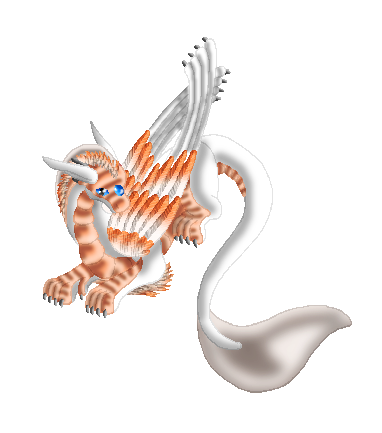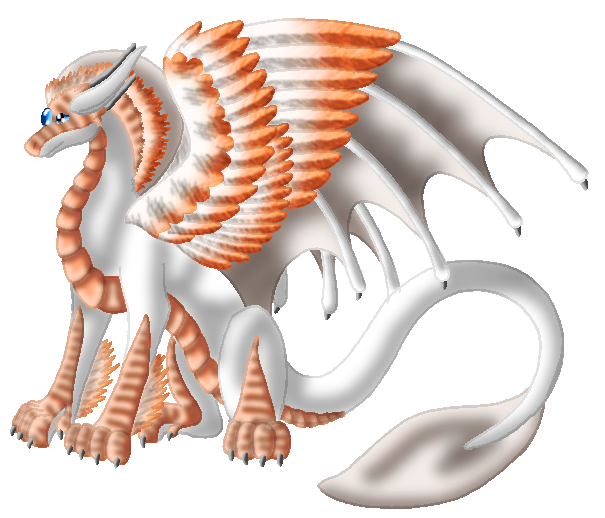Mirus One Year Anniversary Celebratory Something
Moderators: Mystic Dragon, Xalia, Shard
Well, here is a preview of the Fidena Ventul x Mehari Syaess offspring, for the roleplay hatching.

I haven't cleaned or shaded the adult image, but I'll post up the inked sketch for you to see.
http://i19.photobucket.com/albums/b155/ ... 0006-1.jpg
Not quite ready to run the roleplay yet, since I prefer colouring adults and kits at the same time, to get exactly the right colours for both... But... soon it will be ready.
I think Dray said she's not spending so much time online at the moment? Dray, JKat and TyGryph all get one of these regardless of whether you're in the roleplay or not, being owner and artists of the parents.

I haven't cleaned or shaded the adult image, but I'll post up the inked sketch for you to see.
http://i19.photobucket.com/albums/b155/ ... 0006-1.jpg
Not quite ready to run the roleplay yet, since I prefer colouring adults and kits at the same time, to get exactly the right colours for both... But... soon it will be ready.
I think Dray said she's not spending so much time online at the moment? Dray, JKat and TyGryph all get one of these regardless of whether you're in the roleplay or not, being owner and artists of the parents.
- Silver Midnight
- Dragon
- Posts: 754
- Joined: Fri Nov 25, 2005 2:26 pm
- Location: Poisoning the donuts.
- Contact:
0_0
Considering the fact that I'm really no good at RPing, it looks like I'll be doing a lot of it over the next few days.
Man, that is just awesome!
Considering the fact that I'm really no good at RPing, it looks like I'll be doing a lot of it over the next few days.
Man, that is just awesome!
Darkling Dawn: Fauna Frenzy Open to candidates; flights open to males/females; rukel eggs/breedings available.
Drockh-Tallahn Castle: 3 eggs, 2 available. Females and males needed.
Sgiath Wolfkeep: 7 pups available
Sedona Weyr: 12 eggs, Deadline March 8. Chasers and a female needed.
Drockh-Tallahn Castle: 3 eggs, 2 available. Females and males needed.
Sgiath Wolfkeep: 7 pups available
Sedona Weyr: 12 eggs, Deadline March 8. Chasers and a female needed.
Glad you like, Kitsu... and don't worry about the roleplay... everyone who joins gets a dragon, even if they're inexperienced with roleplay.
DNS:
I set up two layers for each type of shading I want to do... for example, I'll have 'shading feathers light' and 'shading feathers dark'. Beneath the shading layers, I have a 'colours' layer, which is coloured in medium hued colours, usually dark, muted reds, blues and purples.
I have black as the foreground palette colour and white as the background palette colour, so I can switch between them easily... I shade all my shadows on the 'dark' layer and white on the 'light' layer. I use a plain airbrush or paintbrush tool, depending on what texture I want, usually at a 15-30 size and 50% to 75% opacity...
Once I've shaded every section of a particular type (ie feathers), I do a Gaussian blur to smooth it out... I usually use a radius between 2 and 5, depending on how smooth I want it... feathers get a 2, fur gets between 2 and 4 depending on how fluffy and soft I want it to look, hide and scales tend to get 5... but it depends on the size of the area, too... small scales will get a 3 usually...
Then, I go to my 'colours' layer, and select all the areas outside of the shading I've just done... so with the feathers shading, I select everything that's not feathers (or select all the feathers and then use Selection Invert). Then go back to the shading layers and delete all the shading that falls under the selections I made... Stops pesky halos around the edges of my images without the need for thick outlines, which'd look weird on my generally outline-less images...
Once all my various shading types are done, I duplicate each and every one of them, and rename them accordingly... so I end up with 'shading feathers light', 'shading feathers light overlay', 'shading feathers dark' and 'shading feathers dark overlay'. As suggested by the names, all the layers now named overlay are set to overlay, while the others remain on normal. This keeps the shading from looking all grey. Then, all of my shading layers are set of 50% opacity. I then delete the background layer, or just make it invisible, depending on if I think I'll need it again.
I use pretty much the same method for shading eyes and gems and the like, but they each have a separate colours layer above all the previous layers, then I select the colour area, and shade within that area on the 'eye shading light' and 'eye shading dark' layers. No Gaussian blurs this time. Then duplicate, rename, overlay and 50% opacity as before. Then a layer above all that is a small white dot or dash...
Then I save and restart my computer to free up the memory before I start colouring... 2gig of ram or not, that many layers slows my system down a lot...
After colouring, I then alter the opacity of the various shading layers to make it look right... darker colours will have the light shading layers reduced to around 30% opacity, while lighter colours will have dark shading layers reduced to about the same, depending on how individual colour combinations look.
Did all that make sense? It's a ridiculously complex method... each image takes me four to eight hours to shade this way... But they're dead quick to colour after all that's done.
DNS:
I set up two layers for each type of shading I want to do... for example, I'll have 'shading feathers light' and 'shading feathers dark'. Beneath the shading layers, I have a 'colours' layer, which is coloured in medium hued colours, usually dark, muted reds, blues and purples.
I have black as the foreground palette colour and white as the background palette colour, so I can switch between them easily... I shade all my shadows on the 'dark' layer and white on the 'light' layer. I use a plain airbrush or paintbrush tool, depending on what texture I want, usually at a 15-30 size and 50% to 75% opacity...
Once I've shaded every section of a particular type (ie feathers), I do a Gaussian blur to smooth it out... I usually use a radius between 2 and 5, depending on how smooth I want it... feathers get a 2, fur gets between 2 and 4 depending on how fluffy and soft I want it to look, hide and scales tend to get 5... but it depends on the size of the area, too... small scales will get a 3 usually...
Then, I go to my 'colours' layer, and select all the areas outside of the shading I've just done... so with the feathers shading, I select everything that's not feathers (or select all the feathers and then use Selection Invert). Then go back to the shading layers and delete all the shading that falls under the selections I made... Stops pesky halos around the edges of my images without the need for thick outlines, which'd look weird on my generally outline-less images...
Once all my various shading types are done, I duplicate each and every one of them, and rename them accordingly... so I end up with 'shading feathers light', 'shading feathers light overlay', 'shading feathers dark' and 'shading feathers dark overlay'. As suggested by the names, all the layers now named overlay are set to overlay, while the others remain on normal. This keeps the shading from looking all grey. Then, all of my shading layers are set of 50% opacity. I then delete the background layer, or just make it invisible, depending on if I think I'll need it again.
I use pretty much the same method for shading eyes and gems and the like, but they each have a separate colours layer above all the previous layers, then I select the colour area, and shade within that area on the 'eye shading light' and 'eye shading dark' layers. No Gaussian blurs this time. Then duplicate, rename, overlay and 50% opacity as before. Then a layer above all that is a small white dot or dash...
Then I save and restart my computer to free up the memory before I start colouring... 2gig of ram or not, that many layers slows my system down a lot...
After colouring, I then alter the opacity of the various shading layers to make it look right... darker colours will have the light shading layers reduced to around 30% opacity, while lighter colours will have dark shading layers reduced to about the same, depending on how individual colour combinations look.
Did all that make sense? It's a ridiculously complex method... each image takes me four to eight hours to shade this way... But they're dead quick to colour after all that's done.
You get a bit of grey, but not much... that image I posted above, he's got a pure white body, and there's some grey there... but I forgot to fix the opacity of the various shading layers on that one... Mostly, when using colours other than white, grey or black, all the highlights and shadows are darker or lighter versions of the colour beneath them... That's the point of having layers on both normal and overlay... normal provides the highlights and shadows, and overlay stops it from getting too grey. If it's looking too grey, you just lower the opacity on the normal layers a bit, and up it on the overlay layers a bit...















